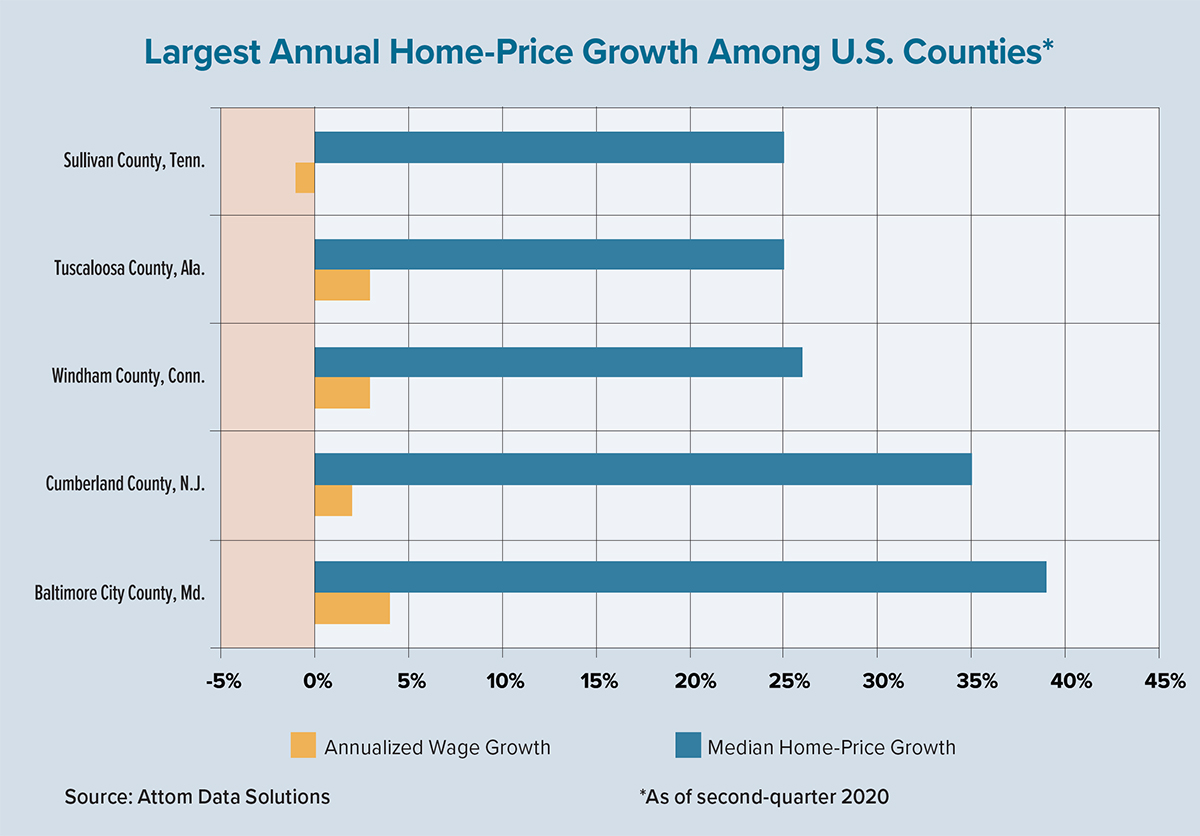Despite the economic uncertainty resulting from the COVID-19 pandemic, home-price appreciation continued to grow faster than wages in two-thirds of U.S. counties analyzed in Attom Data Solutions’ second-quarter 2020 U.S. Home Affordability Report. The report, which included data from 406 counties across the nation, found that 66% of them had home-price appreciation rates that outpaced average weekly wage growth as of this past second quarter.
There were several densely populated areas among the 34% of counties in which wage growth outstripped home-price growth. These included the Southern California counties of Los Angeles, San Diego and Orange, as well as Harris County (Houston), Texas and Kings County (Brooklyn), New York.
As the country began to move into what is typically a busy homebuying season, concerns about the pandemic didn’t dampen home-price appreciation. Median home prices rose by at least 5% year over year in 52% of the counties analyzed in the report. Some areas saw annualized home-price increases of 25% or more at that time, with the largest increase occurring in Baltimore City County, Maryland (39% growth since second-quarter 2019).
Among counties with a population of at least 1 million, the largest year-over-year price gains occurred in Philadelphia County, Pennsyl-vania (up 22%); Bronx County, New York (up 13%); Mecklenburg County (Charlotte), North Carolina (up 12%); Dallas County, Texas (up 11%); and Orange County (Orlando), Florida (up 10%). Of the 406 counties analyzed, only 38 had annualized home-price declines, although many areas saw prices remain flat. Berkshire County, Massachusetts had the largest median home-price decline at 20%.
Although U.S. home prices continue to climb, affordability also is improving, albeit slowly. According to the Attom Data report, median prices for single-family homes and condominiums during the second quarter of this year were more affordable than their historical averages in 49% of the counties studied, up from 31% in second-quarter 2019. Higher wages and lower mortgage costs (a result of declining interest rates) have outweighed the continued home-price gains.
Being “more affordable,” however, doesn’t necessarily equate to actual affordability. For the report, Attom Data calculated affordability for average wage earners by determining the amount of income needed to make monthly payments — including the mortgage, property taxes and insurance — on a median-priced home. This calculation assumed a 3% downpayment and a maximum front-end debt-to-income ratio of 28%. And after comparing this figure to annualized average weekly wage data from the U.S. Bureau of Labor Statistics, median-priced homes remained unaffordable to average wage earners in a whopping 74% of the counties studied this past second quarter. Thus, the major costs of homeownership would consume more than 28% of average wages for roughly three-quarters of the country.
In fact, according to the report, the major costs to own a median-priced home in second-quarter 2020 consumed at least 30% of average wages in 68% of the counties analyzed. Several areas required much more. The highest shares of wages needed to own a median-priced home are found in the California counties of Marin (109.4%), Santa Cruz (98.4%) and Monterey (82.7%), along with Kings County, New York (98.3%) and Maui County, Hawaii (84.1%).
The counties in the report that required less than 30% of average wages to own a median-priced home included Macon County, Illinois, which offered the lowest share of wages needed to own a home at 10.4%. Among the 41 counties in the report with a population of at least 1 million, only five had homeownership costs that consumed less than 30% of wages. These were Cuyahoga County (Cleveland), Ohio; Philadelphia County, Pennsylvania; Harris County, Texas; Fulton County (Atlanta), Georgia; and Oakland County, Michigan.
With continued uncertainty about the ongoing economic effects of the pandemic, it’s unclear how home prices and affordability may be affected in the coming months, especially as unemployment numbers mount. Moderate home-price appreciation combined with continued wage growth could mean positive things for both homebuyers and sellers. ●
Author
-

Todd Teta is chief product and technology officer at Attom Data Solutions, where he leads the company’s technology and product teams. Prior to joining Attom Data Solutions, Teta led the product-development and technology organization at Meyers Research. Teta also previously co-founded several startups, including VisionCore, a company serving the mortgage and real estate data and analytics markets that was later sold to CoreLogic. He is a graduate of the University of Southern California, where he earned a degree in computer engineering and computer science. Learn more about Attom Data Solutions at attomdata.com.
View all posts






